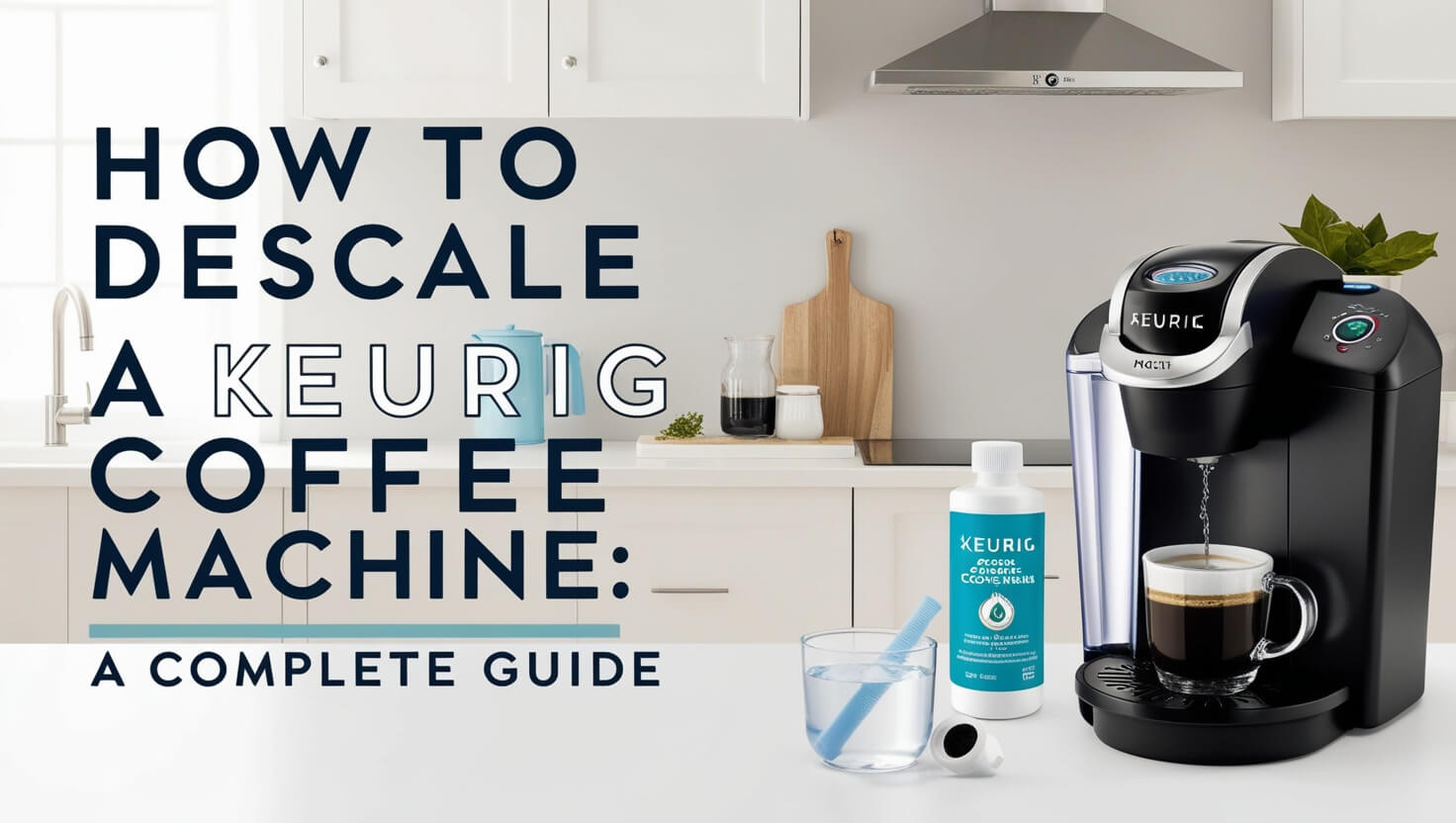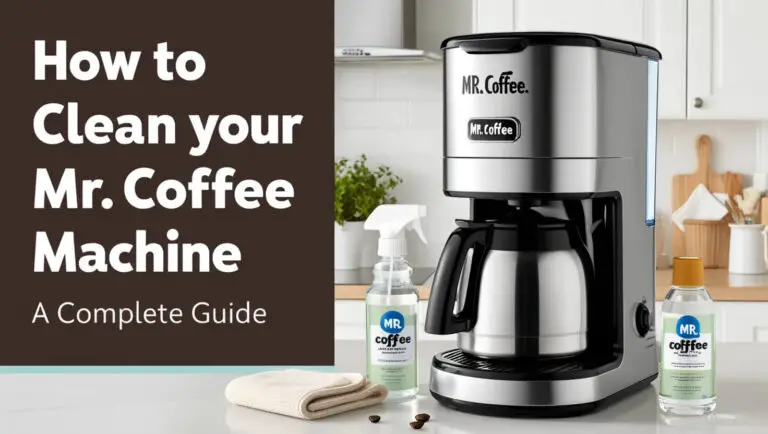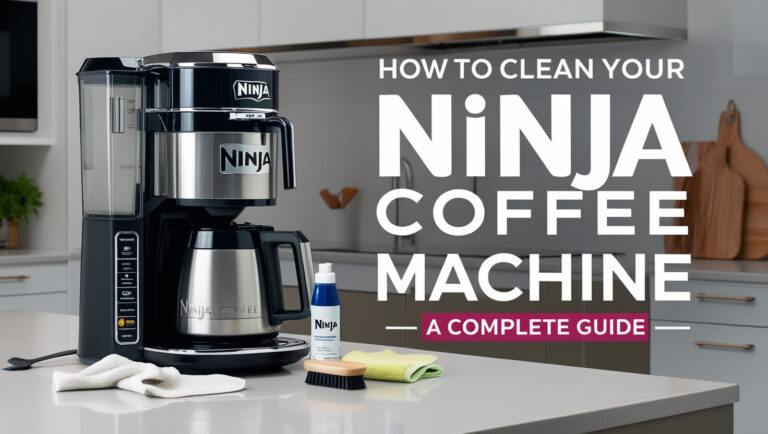How to Descale a Keurig Coffee Machine?

Descaling your Keurig coffee machine is a crucial maintenance task that keeps your brewer running smoothly and your coffee tasting great. This guide will walk you through the process of descaling your Keurig, explain why it’s important, and provide tips to keep your machine in top shape. Whether you’re a coffee enthusiast or just looking to maintain your daily brew, this comprehensive guide has you covered.
Why Descaling Your Keurig is Essential
Descaling is more than just a recommended maintenance task – it’s vital for the longevity and performance of your Keurig coffee machine. Let’s dive into why descaling matters and how it benefits your brewing experience.
Understanding Scale Buildup
Scale buildup occurs when minerals from water accumulate inside your Keurig over time. These minerals, primarily calcium and magnesium, form a chalky residue that can clog your machine’s internal components. This buildup is especially common in areas with hard water.
As scale accumulates, it can:
- Narrow water passages
- Reduce water flow
- Affect brewing temperature
- Alter coffee taste
Benefits of Regular Descaling
Regular descaling offers several advantages:
- Improved coffee taste
- Consistent brewing temperature
- Faster brewing times
- Extended machine lifespan
- Prevention of clogs and malfunctions
By removing scale, you’re ensuring that your Keurig operates at peak efficiency, delivering the best possible cup of coffee every time.
Signs Your Keurig Needs Descaling
Knowing when to descale your Keurig is crucial. Here are some telltale signs that it’s time to give your machine some attention:
Slower Brewing Times
If your once-speedy Keurig is taking longer to brew, it might be due to scale buildup. Scale can restrict water flow, causing the machine to work harder and slower.
Changes in Coffee Taste
Notice your coffee tasting a bit off lately? Scale buildup can affect the water temperature and flow, leading to under-extraction and a less-than-ideal brew.
Unusual Noises During Operation
Strange sounds during brewing, like excessive gurgling or sputtering, could indicate scale interfering with normal water flow.
How Often Should You Descale Your Keurig?
The frequency of descaling depends on several factors, but Keurig recommends descaling every 3-6 months. Let’s look at what influences this schedule and how to determine the right timing for your machine.
Factors Affecting Descaling Frequency
Several elements can impact how often you need to descale:
- Water hardness: Areas with hard water require more frequent descaling.
- Usage frequency: Heavy users may need to descale more often.
- Type of water used: Filtered water can reduce scale buildup.
- Machine model: Some models may be more prone to scaling.
Recommended Descaling Schedule
While the 3-6 month guideline is a good starting point, pay attention to your machine’s performance. If you notice any signs of scale buildup before the 3-month mark, it’s best to descale sooner.
Many Keurig models have a descale indicator light. When this illuminates, it’s time to descale, regardless of the last time you performed the task.
Preparing to Descale Your Keurig
Before diving into the descaling process, it’s essential to gather your supplies and make a few decisions. Proper preparation ensures a smooth and effective descaling process.
Gathering Necessary Supplies
Here’s what you’ll need:
- Descaling solution or white vinegar
- Large ceramic mug
- Fresh water
- Clean, lint-free cloth
Choosing Between Keurig Descaling Solution and Vinegar
You have two main options for descaling your Keurig:
- Keurig Descaling Solution: This is the manufacturer-recommended option. It’s specifically formulated for Keurig machines and is less likely to leave an aftertaste.
- White Vinegar: A more affordable and readily available option. It’s effective but may require additional rinsing to remove the vinegar taste.
While both options work, the Keurig Descaling Solution is generally considered more effective and less likely to cause issues.
Step-by-Step Guide to Descaling Your Keurig
Now that you’re prepared, let’s walk through the descaling process step by step.
Emptying and Preparing the Machine
- Turn off and unplug your Keurig.
- Remove the water reservoir and lid.
- If your Keurig has a water filter, remove it.
- Empty any water remaining in the reservoir.
- Remove the drip tray and empty it.
Adding Descaling Solution
- If using Keurig Descaling Solution:
- Pour the entire bottle into the empty water reservoir.
- Fill the empty bottle with water and add it to the reservoir.
- If using vinegar:
- Fill the reservoir halfway with white vinegar.
- Fill the rest with fresh water.
Running the Descaling Cycle
- Place a large ceramic mug on the drip tray.
- Ensure there’s no K-Cup in the K-Cup holder.
- Close the lid and power on the machine.
- Press the brew button, selecting the largest cup size.
- Once the cycle completes, discard the contents of the mug.
- Repeat this process until the “Add Water” light comes on.
Rinsing the Machine
- Let the Keurig stand for 30 minutes with the power on.
- Remove and rinse the water reservoir thoroughly.
- Fill the reservoir with fresh water to the max fill line.
- Run at least 12 cleansing brews using the largest cup size.
- Discard the water after each brew.
After completing these steps, your Keurig should be descaled and ready for use.
Tips for Maintaining Your Keurig Between Descaling Sessions
While regular descaling is crucial, there are steps you can take between sessions to keep your Keurig running smoothly.
Using Filtered Water
Using filtered water can significantly reduce scale buildup. Consider using bottled water or installing a water filter on your tap if you live in an area with hard water.
Regular Cleaning of Removable Parts
Clean these parts weekly with warm, soapy water:
- Water reservoir and lid
- Drip tray
- K-Cup holder
Rinse thoroughly and allow to air dry before reassembling.
Troubleshooting Common Descaling Issues
Even with careful following of instructions, you might encounter some issues during or after descaling. Here’s how to address common problems:
Machine Not Powering On After Descaling
If your Keurig won’t turn on after descaling:
- Ensure it’s properly plugged in.
- Check if the power outlet is working.
- Let the machine rest for an hour, then try again.
- If it still won’t power on, contact Keurig customer service.
Lingering Vinegar Taste
If you used vinegar and the taste persists:
- Run additional cleansing brews with fresh water.
- Consider using a mixture of baking soda and water for a brew cycle to neutralize the vinegar.
Descaling Light Stays On
If the descale indicator remains lit after descaling:
- Ensure you completed all steps, including the 30-minute rest period.
- Run the descale process again.
- If the light persists, contact Keurig support.
Alternative Descaling Methods for Keurig Machines
While Keurig recommends their descaling solution or vinegar, some users prefer alternative methods. Here are two popular options:
Using Citric Acid
Citric acid is a natural descaler that’s effective and less likely to leave an aftertaste.
- Mix 1-2 tablespoons of citric acid with 4 cups of water.
- Pour the mixture into the water reservoir.
- Follow the standard descaling process.
Baking Soda Method
Baking soda can help neutralize odors and remove light scaling.
- Mix 1/4 cup of baking soda with 1 cup of water.
- Pour into the reservoir and run brew cycles until empty.
- Rinse thoroughly with fresh water.
Note that these methods aren’t officially endorsed by Keurig and may affect your warranty.
The Impact of Water Quality on Your Keurig
The type of water you use in your Keurig significantly affects scale buildup and overall machine performance.
Hard Water vs. Soft Water
Hard water contains higher levels of minerals like calcium and magnesium, leading to faster scale buildup. Soft water, while easier on your machine, may lack minerals that contribute to coffee flavor.
Choosing the Right Water for Your Keurig
Keurig recommends bottled or spring water for the best results. If using tap water, consider a filtration system to remove excess minerals without completely stripping the water of elements that enhance coffee taste.
Descaling Different Keurig Models
While the general descaling process is similar across Keurig models, there are some variations to be aware of:
Keurig 2.0 Series
These models often have a built-in descale function:
- Press the settings button.
- Select the descale function.
- Follow on-screen prompts to complete the process.
Keurig K-Mini
Due to its smaller size:
- Use only a portion of the descaling solution.
- Fill to the max fill line with water.
- Run brew cycles until the reservoir is empty.
Keurig K-Cafe
For models with milk frothers:
- Descale the coffee maker as usual.
- Clean the frother separately with soap and water.
- Run a cleansing cycle with just water through the frother.
Environmental Considerations When Descaling
As we become more environmentally conscious, it’s worth considering the ecological impact of descaling your Keurig.
Eco-Friendly Descaling Solutions
Consider using natural descaling agents like citric acid or a mixture of vinegar and water. These options are biodegradable and less harmful to the environment than some chemical descalers.
Proper Disposal of Descaling Waste
Never pour descaling solution directly into the ground or storm drains. Dispose of it by:
- Diluting it heavily with water.
- Pouring it down the sink while running cold water.
- Checking local regulations for specific disposal guidelines.
Descaling vs. Deep Cleaning: What’s the Difference?
While descaling focuses on removing mineral buildup, deep cleaning addresses other issues like coffee oils and general grime.
When to Descale and When to Deep Clean
Descale every 3-6 months or when indicated by your machine. Deep clean monthly by:
- Washing removable parts with soap and water.
- Wiping the exterior and K-Cup holder area.
- Running a water-only brew cycle.
Combining Descaling with Other Maintenance Tasks
For efficiency, combine descaling with other maintenance:
- Replace the water filter (if applicable).
- Clean the exterior and removable parts.
- Inspect and clean the puncture needle.
FAQs About Descaling Keurig Coffee Machines
Let’s address some common questions about descaling Keurig machines:
Can I Use Vinegar Instead of Descaling Solution?
Yes, white vinegar can be used as an alternative to Keurig’s descaling solution. However, it may require more rinsing and could potentially void your warranty.
How Long Does the Descaling Process Take?
The entire process, including preparation and rinsing, typically takes 45-60 minutes.
Will Descaling Affect My Keurig’s Warranty?
Using Keurig’s official descaling solution won’t affect your warranty. However, using alternative methods might, so check your warranty terms.
Final Verdict: Keeping Your Keurig in Top Shape
Descaling your Keurig coffee machine is a simple yet crucial task that ensures great-tasting coffee and prolongs your machine’s life. By following this guide and maintaining a regular descaling schedule, you’ll enjoy optimal performance from your Keurig for years to come.
Remember, the key to a great cup of coffee isn’t just in the beans – it’s also in the care you give your machine. Happy brewing!





